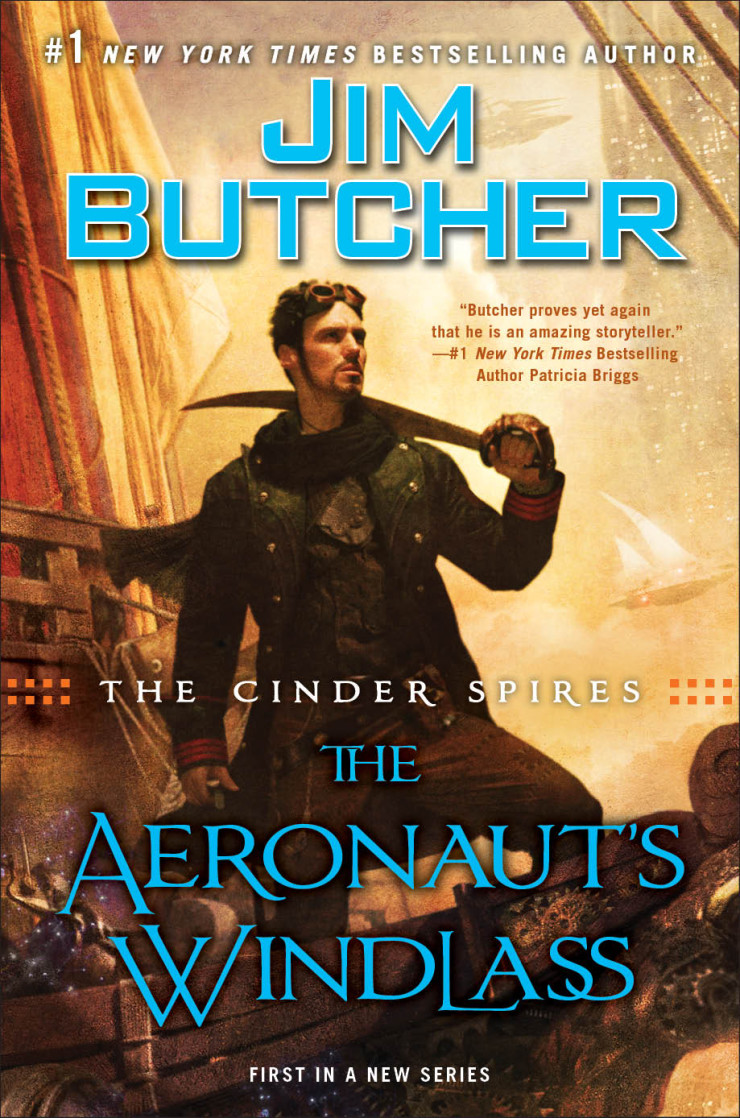When I heard Jim Butcher had a new series coming out, I was a little apprehensive. Of course I wanted to see what he would do with a new book, but I only knew him from his Dresden Files series. When I heard that it was steampunk, in particular, I had mixed reactions.
I love steampunk (I’ve even been accused of writing it) but would Butcher’s version be different enough? Would The Aeronaut’s Windlass have something new to say?
Turns out my fears were unfounded. Butcher doesn’t simply regurgitate an off-the-shelf version of steam-powered contraptions and goggle-clad heroes. There is some steam, and plenty of goggles, but the worldbuilding here is solid and shows us a world that takes equal inspiration from Patrick O’Brian and Star Trek. In Butcher’s world, the people live in Spires, away from the dangerous ground. The Spires are protected by armadas of airships, though not the traditional gas-filled balloons you might be used to. In this world, they grow crystals which provide power, the largest and most powerful of these going into airships. These crystals provide lift and help to steer the ships and enable them to move through the sky. Also aiding these efforts is something called ethersilk, a substance that can catches currents of, well, ether and helps to move the ships as well. Ships also have protective coverings called shrouds, which act something like shields. The end result is that it feels a little like Star Trek in points, down to the (grumpy and unconventional) “engineer” who has to work on the ship’s crystals and drive system. This is not a complaint—I found the echoes of Star Trek only added to my enjoyment and made the ship combat more exciting.
While large crystals power airships, smaller crystals provide light or power gauntlets, personal weapons that seem a bit like Iron Man’s repulsors and tend to replace firearms in this world (though there are also those). Also fitting into the picture are etherealists, a cross between madmen and wizards who use the power of crystals and the ether to manipulate energy and to, potentially, see the future.
One such Etherealist is Efferus Effrenus Ferus, a kind of Obi-Wan like figure. When the Albion Spire is attacked suddenly, Efferus realizes that something larger is afoot and he is sent to investigate. Escorting him are a group of novice guardsmen (all young) and a disgraced airship captain named Grimm. It’s an ensemble cast, but Grimm stands out as perhaps the most heroic of the group as captain of the Predator, a former naval ship, now a privateer.
Other characters include Benedict, a warriorborn who seems to have cat-DNA and is faster and stronger because of it; Gwendolyn, a rich and haughty (but also tough) aristocrat; Bridget, a rather large and strong woman who tends to get herself in trouble; and Rowl, a cat, who helps to get her out. Yes, that’s right—a cat is a main character in this book. Cats play a big part in this world that Butcher has created and this cat person felt he did a good job of capturing their particular behaviors. Rounding out our group is Folly, Efferus’s pupil, also an etherealist, and a member of Grimm’s crew.
The world building in the novel was my favorite part, but also the most frustrating. There’s enough that’s new here and even mysterious that I was drawn in. Butcher doesn’t explain why the ground is so dangerous or why copper is necessary to stop other metals from corroding or how the Spires were built. He doesn’t explain about the warriorborn or where we are in this world’s history. He hints but doesn’t lay everything out. There are clearly many more stories to be told in this world. But that’s not even the frustrating part.
Where he started to lose me is that the setting feels so…white. Yes, he’s drawing from European inspiration, but part of that part of our history is that it opened up the world to lots of different cultures. The closest we get here is a group of people who follow The Way who seem like generic monks who know kung-fu. This is a secondary world fantasy and the focus of the setting feels extremely limited. Why not take the opportunity to add more diversity? It ends up feeling bland and lazy.
Additionally, Butcher goes out of his way to mention that Spire Albion is a democracy and yet there is a Spirearch who is treated like a monarch and there are wealthy Houses who seem to have all the power. It’s like he is trying to cover up the fact that he’s channeling Imperial Britain.
Still, there’s plenty of action here—from hard-fought hand to hand battles against nightmarish creatures to ship combat complete with barrages of broadside cannons. Even the cats get in on the action, proving themselves true predators.
Overall, The Aeronaut’s Windlass is a fun, action-packed and imaginative take on the steampunk genre. Butcher has a promising start to a new series here. I only wish that in future books he adds some diversity to the cast and world as the white, European cast seems bland and unrealistic.
The Aeronaut’s Windlass is available now from Penguin Books.
Rajan Khanna is an author, blogger, and narrator who also writes about airships in a world where the ground is dangerous. Rising Tide, the second novel in a post-apocalyptic airship trilogy, is available now. He tweets @rajanyk.










